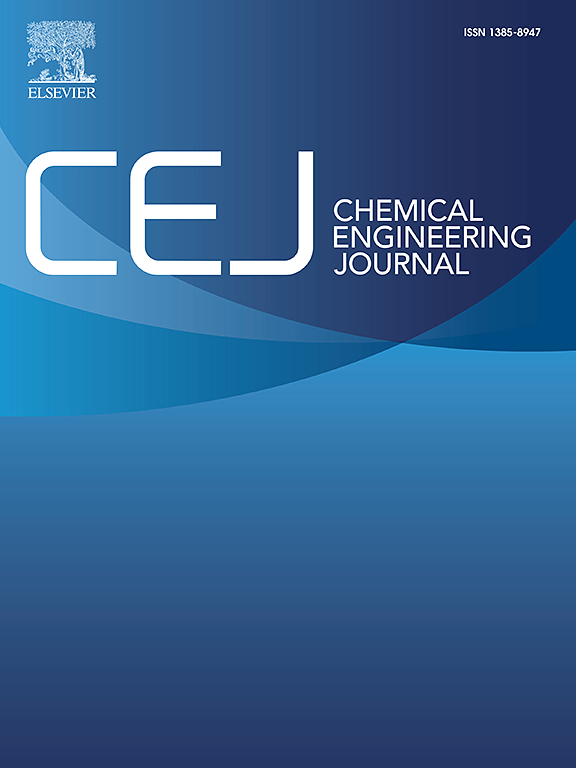Electric field-engineered wood/PPy/ZIF-67 microreactor with synergistic electrocatalysis/PMS activation for high-flux and continuous water purification
IF 13.2
1区 工程技术
Q1 ENGINEERING, CHEMICAL
引用次数: 0
Abstract
Advanced oxidation processes (AOPs) have emerged as pivotal technologies in the removal of organic pollutants by generating highly active radicals. Herein, we present an electric field-engineered continuous-flow microreactor that synergistically couples electrocatalytic oxidation with peroxymonosulfate (PMS) activation for water purification. Hierarchically structured conductive framework is fabricated through具有协同电催化/PMS活化的电场工程木/PPy/ZIF-67微反应器用于高通量连续水净化
高级氧化工艺(AOPs)是通过产生高活性自由基来去除有机污染物的关键技术。在此,我们提出了一种电场工程连续流微反应器,它可以协同耦合电催化氧化和过氧单硫酸盐(PMS)活化用于水净化。通过在聚吡咯(PPy)改性轻木中原位生长ZIF-67纳米片,制备了分层结构的导电框架。PPy层为有效的电荷转移建立了电子高速公路,而ZIF-67纳米片作为PMS活化催化剂,可以调节微通道结构,加强反应物-催化剂的接触。在每个细胞腔内,电场耦合的电催化氧化和PMS活化催化同时发生。多反应协同和微通道增强集成系统表现出突破性的性能,在15 V直流电压下,对10 mg·L−1亚甲基蓝的降解率可达99%,在1552.5 L/m2·h的高通量下,连续运行16 h,降解率保持在96%以上。在各种染料和含四环素的水的管理中也表现出广谱的适用性。这项工作为可持续生物质利用的水净化和微反应器设计提供了开创性的策略。
本文章由计算机程序翻译,如有差异,请以英文原文为准。
求助全文
约1分钟内获得全文
求助全文
来源期刊

Chemical Engineering Journal
工程技术-工程:化工
CiteScore
21.70
自引率
9.30%
发文量
6781
审稿时长
2.4 months
期刊介绍:
The Chemical Engineering Journal is an international research journal that invites contributions of original and novel fundamental research. It aims to provide an international platform for presenting original fundamental research, interpretative reviews, and discussions on new developments in chemical engineering. The journal welcomes papers that describe novel theory and its practical application, as well as those that demonstrate the transfer of techniques from other disciplines. It also welcomes reports on carefully conducted experimental work that is soundly interpreted. The main focus of the journal is on original and rigorous research results that have broad significance. The Catalysis section within the Chemical Engineering Journal focuses specifically on Experimental and Theoretical studies in the fields of heterogeneous catalysis, molecular catalysis, and biocatalysis. These studies have industrial impact on various sectors such as chemicals, energy, materials, foods, healthcare, and environmental protection.
 求助内容:
求助内容: 应助结果提醒方式:
应助结果提醒方式:


